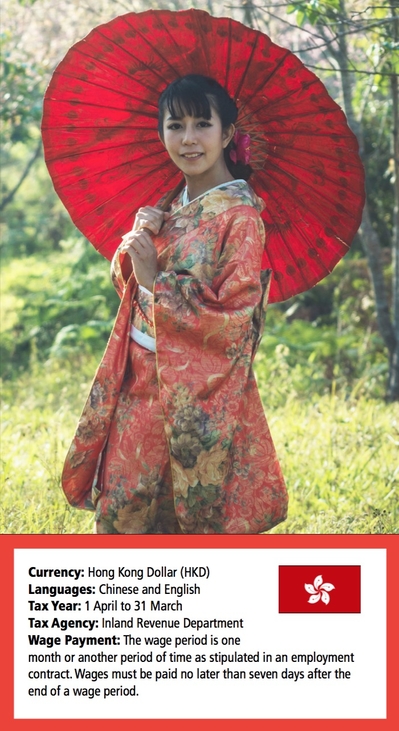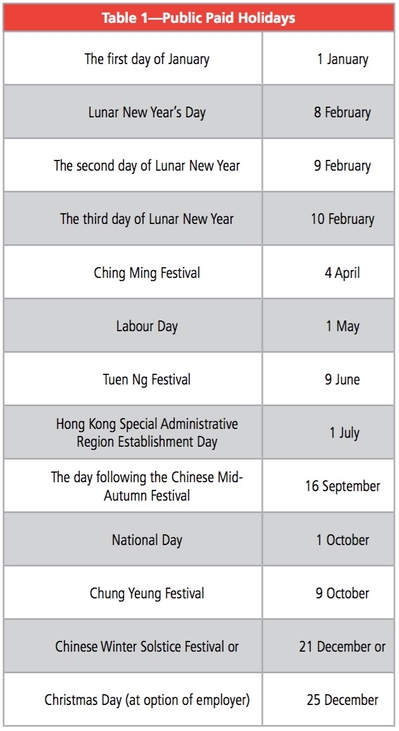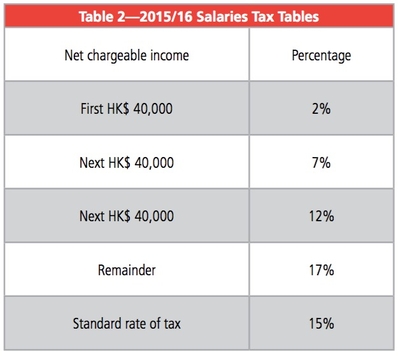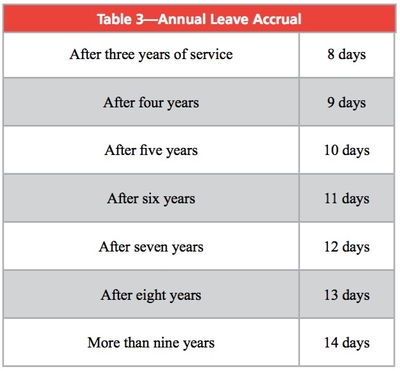 Hong Kong is an autonomous territory located in southeastern China. Its population of approximately 7.2 million is made up mostly of Han Chinese, and its area is about six times the size of Washington, D.C. Hong Kong is a free-market economy.
Hong Kong is an autonomous territory located in southeastern China. Its population of approximately 7.2 million is made up mostly of Han Chinese, and its area is about six times the size of Washington, D.C. Hong Kong is a free-market economy.
Employment
The wage period is one month or another period of time as stipulated in an employment contract. Wages must be paid no later than seven days after the end of a wage period. Wages are paid directly to an employee on a work day at the place of employment in cash or, with the consent of the employee, by check, money order, postal order, or transferred to a bank account or to the employee’s agent.
Labor Standard Act or Employment Act—The Employment Ordinance is the main legislation prescribing the minimum rights, benefits, and protection for employers and employees in Hong Kong. It was enacted in 1968.
Minimum wage—The current statutory wage rate is HK$32.5 per hour as of May 1, 2015.
Working hours—Working hours are typically 9 a.m.-6 p.m. Monday-Friday. There are no legislative requirements on maximum working hours except in the case of a young person in industrial settings. A young person, categorized as over age 15 and under 18, is limited to eight work hours a day during the hours of 7 a.m. to 7 p.m. in a 48-hour week.
Overtime pay—There is no law in Hong Kong requiring the payment of overtime. Extra pay for overtime can be outlined in the employment contract.
Employment contracts—Under conditions outlined in the Employment Ordinance, employees must be informed of their employment conditions before employment begins. It should include:
- Wages, including rate of pay, overtime rate, and any allowances and how the allowance is calculated, such as day, week, by the piece or otherwise
- Wage period
- Length of notice required to terminate the contract
- If the employee is entitled to any year-end payment or a proportion and the payment period
Taxes
In Hong Kong, the tax year runs from 1 April through 31 March. All employers are required to notify the Inland Revenue Department of the commencement and cessation of employment of its employees within a stated time. A person’s income from employment, less allowable deductions, charitable donations, and personal allowances, is chargeable to salaries tax at progressive rates (see Table 2).
 Tax Policy
Tax Policy
- Maximum salaries tax rate 15%
- Profits tax rate 16.5%
- Property tax rate 15%
- No VAT or sales tax
- No capital gains tax
- No withholding tax on dividends and interest; no estate duty
- No global taxation; only Hong Kong-sourced income taxable
- Payment due dates—10th of following month
- Social Insurance Programs—Mandatory Provident Fund (MPF)
MPF is an employment-based retirement protection system. All employees and self-employed persons between 18 and 65 are required to join the MPF scheme. Employees should be enrolled within the first 60 days of employment.
An employer and employee must each contribute at least 5% of the employee’s income to the individual employee’s MPF account. The maximum relevant income level of monthly paid employees is HK$30,000, and the highest mandatory contribution for each employer and employee is HK$1,500 a month.
Leave Entitlements
An employee is entitled to seven days’ paid annual leave after 12 months of service under a continuous contract with the same employer.
Leave is increased according to an employee’s length of service (see Table 3).
The employer should confirm the timing of annual leave by a written notice to the employee at least 14 days in advance, unless they have mutually agreed on a shorter period.
Paid annual leave should be taken for a continuous, unbroken period. However, at the employee’s request, an employee who is entitled to 10 days or fewer of annual leave may take up to three days separately. An employee who is entitled to more than 10 days of annual leave should take at least seven days consecutively.
An employee may accept pay in lieu of leave only for that part of leave that exceeds 10 days. If an employee leaves before completing one year of service, the employee is entitled to prorate annual leave pay on completion of three months unless the employee is summarily dismissed.
 Paternity leave—Male employees with a child born on or after 27 February 2015 are entitled to three days’ paternity leave to be taken consecutively or separately for each confinement of their spouse/partner if they fulfill other requirements as stipulated in the law. They may take paternity leave at any time during the period from four weeks before the expected date of delivery of the child to 10 weeks beginning on the actual date of delivery of the child. Employees who are qualified for paternity leave pay may receive a daily rate of four-fifths of their average wages as paternity leave pay.
Paternity leave—Male employees with a child born on or after 27 February 2015 are entitled to three days’ paternity leave to be taken consecutively or separately for each confinement of their spouse/partner if they fulfill other requirements as stipulated in the law. They may take paternity leave at any time during the period from four weeks before the expected date of delivery of the child to 10 weeks beginning on the actual date of delivery of the child. Employees who are qualified for paternity leave pay may receive a daily rate of four-fifths of their average wages as paternity leave pay.
Annual leave (vacation)—Employees are entitled to a minimum of between seven and 14 days annual leave for each period of 12 months employment under a continuous contract, calculated on the basis of length of service (see Table 3).
Maternity leave—An employee is eligible for 10 weeks’ paid maternity leave if:
- She has been employed under a continuous contract for not less than 40 weeks immediately before the commencement of scheduled maternity leave
- She has given notice of pregnancy and her intention to take maternity leave to her employer after the pregnancy has been confirmed, such as by presenting a medical certificate confirming her pregnancy to the employer
- She has produced a medical certificate specifying the expected date of confinement if so required by her employer
 Culture
Culture
Punctuality is important in Hong Kong and should be respected. Tea is served during business meetings, but be sure to allow the host to take the first sip. When presenting a business card, hold it in both hands with the text facing the person receiving it. When receiving a business card, read it and never write on the business card, which is a sign of disrespect.
Take time to build relationships. It may take several meetings to accomplish goals. Do business face to face. Courtesy calls and personal selling are vital to success. “Yes” may not mean agreement; it often means “I hear you.” “No” is generally not said. Instead, you may hear, “I will have to wait” or “This may be very difficult.”
Hong Kong residents are very style-conscious and dress well. Modesty and cleanliness are important. Gift-giving is a tradition in Hong Kong that communicates respect and friendship. Be prepared to present a small gift at the first meeting, such as high-quality cognac, brandy, candy, or pens. Unlike other Asian countries, Scotch whisky is not special in Hong Kong.
Avoid giving white or red flowers (white is a symbol of mourning, red a symbol of blood). Clocks are associated with death, but watches are suitable gifts. Shake hands with everyone—men, women, and children—upon meeting and leaving. Note that Hong Kong Chinese handshakes may be less firm than a Western handshake.
Higher-ranking persons are introduced before those of lower rank. An older person comes before a younger person, and a woman before a man. Family members are greeted in order of age, oldest first and youngest last.